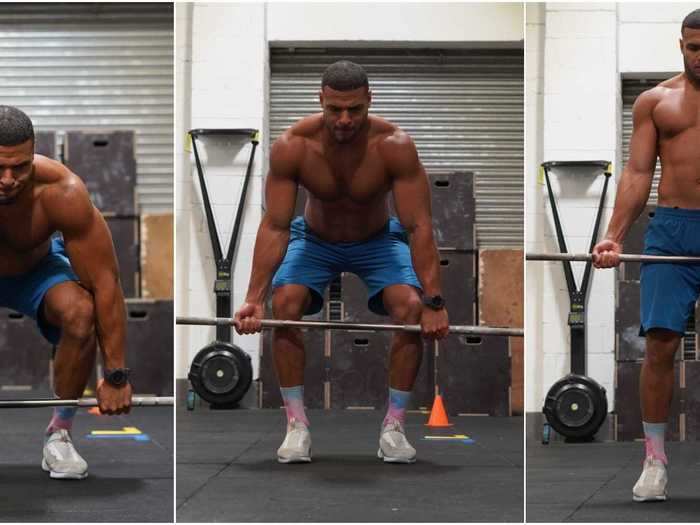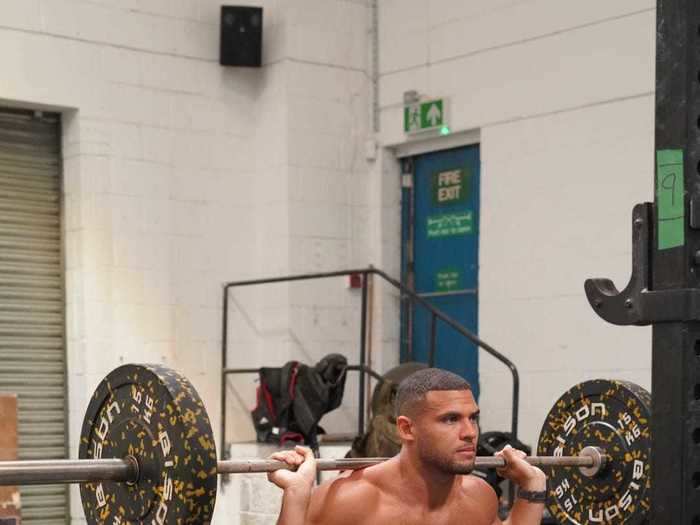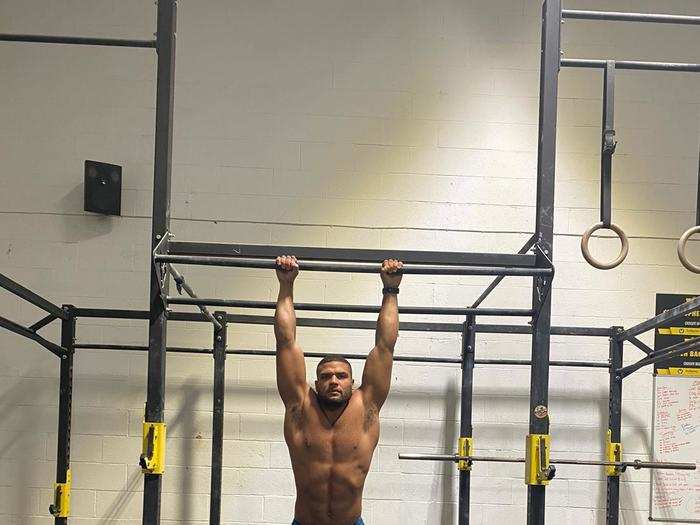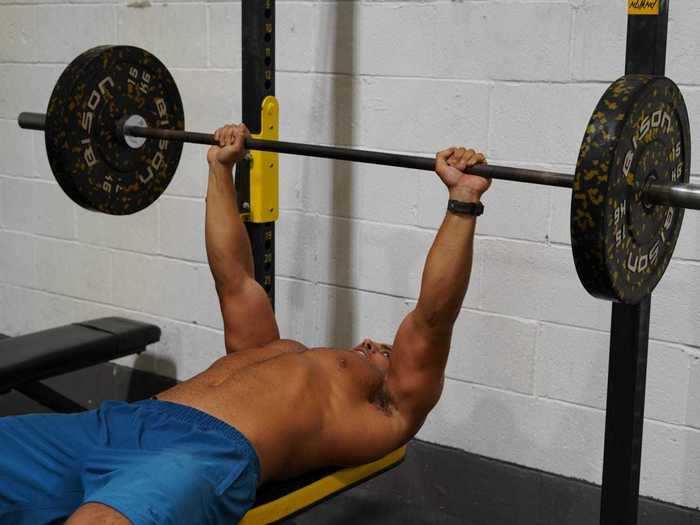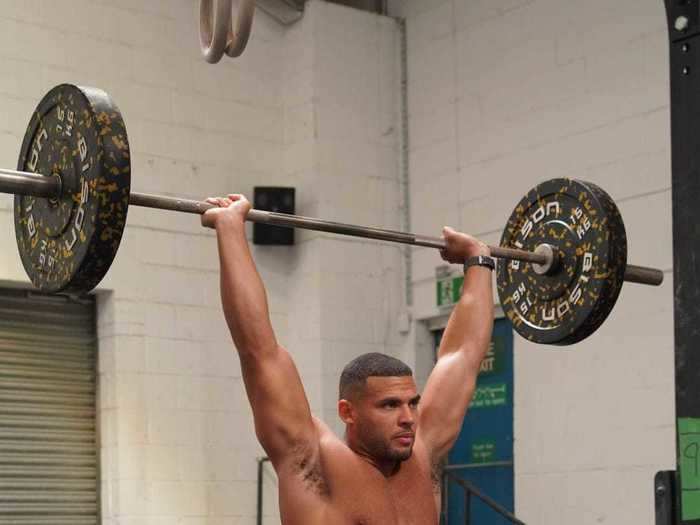Zack George performing a squat and deadlift.Zack George
- The best way to build muscle is to perform compound exercises which recruit multiple muscle groups.
- According to Zack George, personal trainer, gym owner, and the UK's fittest man, there are five main movements to focus on.
- These are deadlifts, squats, pull-ups, bench press, and shoulder press.
- George explained to Insider how to perform each exercise, and how to structure a training plan for maximum gains.
- Adequate nutrition and recovery also play a role in muscle-building.
There are a lot of benefits to building muscle that go beyond looking good and being able to pick up heavy things, as Insider's Laura Goldman reported.
But whether your desire to get stronger comes from health or aesthetic motivations, there are five key exercises you should focus your training around, according to Zack George, a qualified personal trainer and the UK's fittest man (he came top in the UK in the 2020 CrossFit Open).
The exercises are:
- Deadlifts
- Squats
- Pull-ups
- Bench press
- Shoulder press
Compound exercises recruit multiple muscle groups at once
Each exercise is a compound movement, which means it works multiple muscle groups as opposed to isolation exercises, such as bicep curls.
"Recruiting multiple muscle groups in this way makes these movements more effective at building muscle as you work more muscles and multiple joints through large ranges of motion, which enables you to move more weight than in isolation exercises, and better progressively overload your muscles for big gains," George said.
It's crucial to train with progressive overload, which means gradually challenging your muscles by increasing the weight or reps performed.
Perform each exercise twice a week
When it comes to structuring your workout plan, George, who owns CrossFit BFG gym in Leicester, UK, recommends performing all five movements twice a week, but using different rep schemes and weights.
Session 1: 12 reps of each exercise for 5 sets, at a weight that is challenging but allows you to maintain good form throughout. "The last couple of reps in each set should be a struggle," he said.
Session 2: 8 reps of each exercise for 5 sets, but this time with heavier weight. "Make sure you keep good form throughout still, don't let your ego get the better of you," George said. "If you need to scale back the weight, do it. It's much more important to perform the movements correctly and avoid injury."
Sets of 8-12 reps are widely considered to be the best for hypertrophy (muscle growth) - training in sets of lower reps is usually done when the focus is strength, and higher reps are usually designed with fat loss in mind.
What you do in the gym is only part of the picture - recovery, diet, and nutrition also play an important role (you'll build muscle fastest if you're eating in a calorie surplus, but you'll also likely gain some fat).
Ultimately though, you need to be patient and consistent. Building muscle is a slow process, so you have to stick with it. Here are the movements to work on:
1. Deadlifts
Zack George performing a deadlift.
Zack George
There are various different types of deadlifts, all of which will work many muscle groups. Here's how to perform a conventional one:
"With your feet hip-width apart directly under the barbell, hinge at the hips and knees and place your hands on the bar, shoulder-width apart, just outside of your shins," George said. "Make sure your back is straight (in a neutral spine position), pull your shoulders back, and engage your core, keeping it tight to create tension."
Using the strength of your legs, pull the bar from the floor, keeping it close to your body at all times, traveling up your shins and over your knees as you extend the hips.
He continued: "Never pull using your back and never round your back in the movement — if you feel this happen, stop. Bring the barbell all the way up so you're standing straight, and fully extend your hips and knees."
Lowering the barbell should be done carefully with control too.
"Think of it as reversing the movement you've just done — send your hips back and lower the bar down following the same bar path you just used to pick it up," George said.
2. Squats
Zack George performing a squat.
Zack George
There are various ways to perform squats, but George recommends prioritizing back-squats (i.e. having the barbell across the top of the back).
"Using a squat rack, duck your head under the bar and rest it across the meaty part of your upper back, holding it with your hands," he said. "Lift the bar out of the rack and take a step or two back. Your feet should be around shoulder-width apart, keeping the weight in your heels and mid-foot."
Bring your elbows forward under the bar, which might feel odd at first, but it will help you keep a strong neutral spine position and stop you from rounding forward.
"Engage your core, keep it tight, and think about keeping the chest up at all times — a good way to do this is to choose a point above eye-level to focus on, as well as taking a big inhale and filling your lungs as you start to lower," he added.
To perform the squat, hinge the hips and sit back as if you're sitting down on a chair. Ideally you want to descend until your hip crease is below your knee, but each body is unique and will move differently.
"As you hit full depth, quickly use the power of your legs, while keeping core tight and engaged and chest up, to drive the bar back up and fully extend your hips and knees to reach the top of the movement," George said.
3. Pull-ups
Zack George preparing to perform a pull-up.
Zack George
Pull-ups work slightly different muscle groups depending on your hand positioning, but they work more of the body than most people realize. George explained how to perform a standard one properly.
"Jump up and grab the bar with your hands approximately shoulder-width apart and your palms facing away from you. If your palms are facing towards you, you're performing a chin-up, not a pull-up, and that's a different movement entirely," George said.
He continued: "Hanging from the bar, you want to be in a hollow body position — this means your body should be compact, think of creating a slight C shape. Legs should be squeezed together, keep your core tight, back and lats engaged, and shoulders pulled back."
Keep your eyeline straight ahead and pull your body straight up towards the bar until your chin passes it.
"Carefully lower yourself back to the hanging position, keeping a tight body throughout the whole movement to avoid swinging, and repeat," George said.
If you can't perform an unassisted pull-up yet, try using a large resistance band hanging from the bar (place your knees or a foot inside the loop) or perform negative pull-ups, where you jump up to the top position, then slowly lower yourself with control.
4. Bench press
Zack George at the top of a barbell bench press.
Zack George
The bench press is a really effective compound movement, working mainly the shoulders, triceps, and pecs.
"Using a bench, lie down on your back with your feet placed firmly flat on the floor and your eyes directly under the barbell," George said. "Keep your wrists neutral, core, feet, legs, and glutes tight and engaged. Think about pushing your feet into the ground. Place your hands slightly wider than shoulder-width apart on the barbell."
Once your set-up position is strong, you're ready to perform the bench press.
"Carefully lift the bar out of the rack and straighten your arms, with the bar suspended straight above your chest," George said. "Lower the bar to your chest and gently tap mid-chest, this should be a very controlled movement, no crashing the barbell onto your chest. To press the bar back up again, keep your elbows in close to the body, no flaring them out, and push the bar back up above you until your arms are fully extended and stable."
5. Shoulder press
Zack George at the top of a shoulder press.
Zack George
Like all these exercises (except pull-ups), the shoulder press can be performed with different equipment, but George recommends a barbell. Here's how to do it.
"Use a squat rack to pick the bar up from," George said. "Place your hands on the bar approximately shoulder-width apart, push your elbows through, and position the bar in a front rack position, resting across the front of your shoulders. Lift the bar out of the rack and take one or two steps back."
He continued: "Your feet should be about hip-distance apart and your core, legs, and glutes should be tight and engaged, but make sure not to use the legs to drive the bar up — you're going to use the strength of the upper body, but your legs, glutes, and core need to be tight for stability."
Then it's time to push the barbell up and over your head until your arms are fully locked out and your head comes through.
"Pause for just a second at the top to stabilize and complete the rep, and then carefully lower the bar back down to the front rack position," George said.

